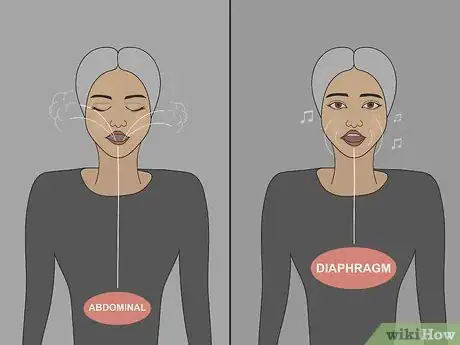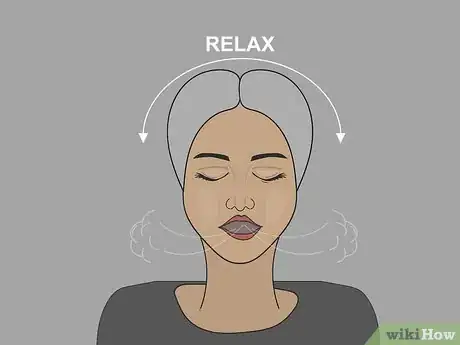This article was co-authored by Tanisha Hall. Tanisha Hall is a Vocal Coach and the Founder and Executive Director of White Hall Arts Academy, Inc. an organization based in Los Angeles, California that offers a multi-level curriculum focused on fundamental skills, technique, composition, theory, artistry, and performance at a conservatory level. Ms. Hall's current and previous students include Galimatias, Sanai Victoria, Ant Clemons, and Paloma Ford. She earned a BA in Music from the Berklee College of Music in 1998 and was a recipient of the Music Business Management Achievement Award.
This article has been viewed 35,778 times.
Alto refers to the second highest vocal range in choral music, above the tenor and bass ranges but below soprano. Singing alto is all about hitting low notes with a warm, open tone instead of a breathy singing voice. Although anyone can be an alto singer, women are more often able to sing in the alto range than men. In order to sing alto, you’ll need to figure out if you have a good voice type for alto singing or if you need to expand your vocal range. Then, by mastering the techniques used in this type of singing, you can do a better job of singing alto, whether by yourself or as part of a chorus.
Steps
Mastering the Techniques of Singing Alto
-
1Keep your throat and vocal cords relaxed to avoid restricting air flow. Rest your tongue at the top of your bottom teeth while you’re singing and release the tension in your jaw muscles. If you find it difficult to “will” your muscles to relax, you can also perform small massages with the backs of your hands to keep your throat muscles loose and relaxed.[1]
- To do this type of massage, place the backs of your hands along the sides of your throat and use slight pressure to move your larynx from side to side. Take several slow, deep breaths with your larynx positioned on either side of your throat to loosen it.
- You may notice that jutting your lower jaw forward makes your singing clearer and fuller, as well as less “airy.” Although doing this helps to improve air flow, it also creates unwanted tension in your jaw muscles, so it’s not an effective long-term technique to use.
-
2Use abdominal breathing to sing from your diaphragm. This method of breathing helps air in your lungs when your singing, creating the right amount of air pressure for good singing, and keeps air flowing smoothly through your body. Breathe deeply into your abdomen instead of your chest, so that your abdomen rises as you inhale.[2]
- If you’re not sure if you’re doing abdominal breathing properly, lie down flat with your knees bent, 1 hand placed on your chest, and the other hand on your stomach. When you use abdominal breathing, the hand on your stomach should rise while the hand on your chest remains in place.
- If you’ve never used this method of breathing before, practice abdominal breathing about 5-10 times every day until it becomes more comfortable for you.
Advertisement -
3Sing using your chest voice to keep your singing voice low.[3] Your chest voice is simply the voice you usually use when talking and uses a thicker, more powerful muscle than singing with an airier “head voice.” Place your hand on your chest when speaking and you’ll notice that when you use a lower-sounding chest voice, your chest resonates.[4]
- To sing in your chest voice, begin speaking with your normal speaking voice, then slowly transition to an “ooh” sound. You should be able to feel the “ooh” resonate in your chest. If you can’t, lower the register of the “ooh” sound until you feel the resonance.
- Start off singing softly since your chest voice won't have much flexibility at first. Gradually increase your volume over time.[5]
-
4Keep your tone rich and full to avoid sounding too breathy. This is done by creating a more open space in your nose, mouth, and throat. Slowly inhale through your nose, then through your mouth, then perform a relaxed yawn. As you do these exercises, pay attention to how the passageways in your nose, mouth, and throat feel like they’ve been expanded by the air rushing in. Creating and maintaining this expanded feeling is how you create open space.[6]
- If you have trouble identifying these passageways, try humming with your mouth closed and “moving” the sensation of humming up and down your headspace. You should be able to feel that hum in your nose as well as your mouth and throat.
-
5Try singing in a choir or group with other altos. In a vocal group, you and the other alto singers will all be singing the same notes. This will allow you to hear how other altos sound when hitting low notes and have a better idea of how you should be singing these notes if you’re just starting out.[7]
- Many churches, high schools, and universities have singing groups that include lots of opportunities for singing alto.
- If you don’t live near one of these groups, consider reaching out to other singers in your area through the internet and starting your own singing group!
Assessing Your Voice Type
-
1Sing along to a piano note that feels near the bottom of your register. Pick a note to play on the low end of a piano or keyboard that you know you can comfortably sing along to. If you think you’re an alto, look for your lowest note around middle C, which is the C note that is closest to the middle of the piano.[8]
- If you don’t have access to a physical piano-like instrument, you can also use a piano app or online simulator to access a full keyboard and test your singing voice.
- If your piano or keyboard has the name of its manufacturer or vendor on it, middle C is traditionally located directly underneath this name on the piano.
- Don’t try to sing as low a note as you possibly can just yet. For now, just try to guess where your lowest comfortable note is. This should be a note that you can comfortably sustain and hit consistently.
-
2Move down a half step and see if you can sing this lower note. To move down a half step on a piano, simply play the key immediately to the left of the key you just played. Again, see if this is a note that you can play comfortably and consistently, not just 1 time.[9]
- If you just played a white key and there’s a black key to the upper left of that key, play the black key (instead of the white key to the immediate left) in order to move down a half step.
-
3Continue moving down in half steps until you reach your lowest note. Your goal here is to find the lowest note that you can comfortably and consistently play throughout the length of an entire song. Once you reach a note that you have to strain to sing along to, the note immediately before that one is the bottom of your vocal register.[10]
- For an alto singer, the bottom of your vocal register should be at or around the E3 note. On most pianos, this is the 32nd white key from the left.
-
4Repeat this process moving up from middle C to find your highest note. Play keys to the right of middle C, moving a half step at a time and trying to sing along to each note. The last note that you can comfortably and consistently hit is the high end of your vocal register.[11]
- For alto singers, their vocal register typically goes up to the E5 note, which is usually the 56th white key from the left.
Expanding Your Vocal Range
-
1Remember to stay calm and relaxed. When you’re singing notes outside of your regular range for your first time, you’re likely to either force more air through your throat than necessary or restrict air flow because you’re not fully relaxed. Additionally, maintaining relaxed vocal muscles is the optimal way to make your notes sounds as good as possible.[12]
- Start any practice session with a few relaxing deep breaths. Then, sing a few of the notes that you’re most comfortable with to warm up your vocal cords.
-
2Use an “ah” sound to practice notes at the limits of your range. Start by singing a high note just beyond your regular range, then “slide” all the way down to the bottom of your vocal range and into the even lower notes. This sound is particularly easy for your singing muscles to produce, making it a good sound to use when practicing notes you’re uncomfortable with.
- When singing notes on the high end of your vocal range, you can also use rounded, closed vowel sounds like “ee” or “oo.”
-
3Practice new notes in short spurts every day. You need to train and build up your vocal muscles, which takes time and commitment; it won’t happen overnight. Instead, spend 30-45 minutes every day practicing notes at the high and low ends of your vocal range, devoting particular attention to any notes within the alto vocal range that you don’t normally sing.
- For best results, perform these practice sessions early in the morning, as this is when your voice is the most open and best able to hit notes outside your normal range.
- Perform your practice singing in private, at least when you’re just starting out. Singing in front of others may add to your nerves and put added stress on your vocal muscles, which are already being stressed by singing beyond the notes that they’re used to.
References
- ↑ https://www.musicnotes.com/blog/2014/08/22/improve-vocal-range/
- ↑ https://www.musicnotes.com/blog/2014/08/22/improve-vocal-range/
- ↑ Tanisha Hall. Vocal Coach. Expert Interview. 27 March 2020.
- ↑ https://www.youtube.com/watch?v=Ds1DirIpH1o#t=18s
- ↑ Tanisha Hall. Vocal Coach. Expert Interview. 27 March 2020.
- ↑ https://www.youtube.com/watch?v=5xSkiRPNC8k#t=01m55s
- ↑ https://ourpastimes.com/how-to-sing-alto-12117523.html
- ↑ http://www.howtosingsmarter.com/tips-for-singers-vocal-range/
- ↑ http://www.howtosingsmarter.com/tips-for-singers-vocal-range/





































































